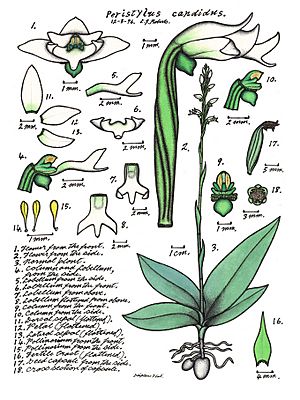White ogre orchid facts for kids
The White Ogre Orchid, also known as Peristylus maingayi, is a special type of orchid. It grows naturally in places like southern Indochina, New Guinea, and northern Queensland. This orchid usually has two or three wide leaves close to the ground. It can also have up to fifteen small, white flowers. These flowers are shaped like tubes at the bottom. They also have a unique three-part lip, called a labellum.
Quick facts for kids White ogre orchid |
|
|---|---|
 |
|
| Drawing of "P. candidus" (synonym) by Lewis Roberts | |
| Scientific classification | |
| Genus: |
Peristylus
|
| Species: |
maingayi
|
| Synonyms | |
|
|
Contents
What the White Ogre Orchid Looks Like
The White Ogre Orchid is a tuberous plant. This means it grows from a round, underground stem called a tuber. It is also a perennial herb. This means it lives for more than two years and has soft stems, not woody ones.
Leaves and Stems
This orchid usually has two or three leaves. These leaves are about 40–80 mm (2–3 in) long. They are also about 20–25 mm (0.8–1 in) wide. The plant grows a flowering stem that can be 120–450 mm (5–20 in) tall.
Flowers and Their Parts
Each stem can hold between eight and fifteen white flowers. These flowers are shaped like tubes. They are about 6–7 mm (0.24–0.28 in) long and 7–8 mm (0.28–0.31 in) wide.
The flower has different parts:
- The dorsal sepal is like a top petal. It is 5–6 mm (0.20–0.24 in) long and 3 mm (0.1 in) wide. It forms a small hood over the center of the flower.
- The lateral sepals are on the sides. They are similar in length to the top sepal but a bit narrower. They spread out from each other.
- The petals are mostly triangular. They are about 5 mm (0.2 in) long and 3 mm (0.1 in) wide.
- The labellum is the special lip of the orchid. It is 5–6 mm (0.20–0.24 in) long and 4 mm (0.2 in) wide. Its tip is divided into three parts, or lobes. Each lobe is about 2 mm (0.08 in) long and 1 mm (0.04 in) wide.
This orchid usually blooms from March to May.
How the White Ogre Orchid Got Its Name
The White Ogre Orchid was first officially described in 1897. Two botanists, George King and Robert Pantling, gave it the name Habenaria maingayi. They wrote about it in a scientific journal called Journal of the Asiatic Society of Bengal.
Later, in 2001, two other scientists, Jeffrey James Wood and Paul Abel Ormerod, changed its name. They renamed it Peristylus maingayi. The second part of its name, maingayi, honors a person named Alexander Carroll Maingay. He was the one who collected the first plant sample, called the type specimen, that was used to describe this species.
Where the White Ogre Orchid Lives
Peristylus maingayi likes to grow in wet areas. You can find it in swampy grasslands. It also lives in grassy forests and woodlands. This orchid is found in a region called Malesia. It also grows in countries like Cambodia and Vietnam. You can also see it in New Guinea and northern Australia. In Australia, it lives on the Cape York Peninsula and as far south as Proserpine.

